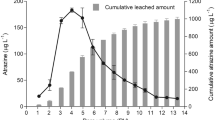Abstract
The stability of exogenous ATP in Antarctic Ross desert soils has been assessed using bioluminescence monitoring of ATP-supplemented samples. Under typical east Antarctic dry valley summer conditions (−3 to +15°C), exogenous ATP was degraded with a half-life of between 0.5 and 30 h. The rate of degradation was affected, in order of significance, by soil biomass levels, temperature and water content. Such rapid removal of exogenous ATP strongly suggests that extracellular ATP from lysed cells in cold desiccated soils does not make a significant contribution to the standing ATP titre



Similar content being viewed by others
References
Aycicek H, Oguz U, Karci K (2006) Comparison of results of ATP bioluminescence and traditional hygiene swabbing methods for the determination of surface cleanliness at a hospital kitchen. Int J Hyg Environ Health 209:203–206
Bancroft K, Paul EA, Wiebe WJ (1976) The extraction and measurement of adenosine triphosphate from marine sediments. Limnol Oceanogr 21:473–480
Berg AS, Joern BC (2006) Sorption dynamics of organic and inorganic phosphorus compounds in soil. J Environ Qual 35:1855–1862
Cameron RE, King J, David CN (1970) Microbiology, ecology and microclimatology of soil sites in dry valleys of South Victoria Land, Antarctica. In: Holdgate M (ed) Antarctic ecology, vol. 2. Academic, London, pp 702–716
Cowan DA, Russell NR, Mamais A, Sheppard D (2002) Antarctic dry valley mineral soils contain unexpectedly high levels of microbial biomass. Extremophiles 6:431–436
Davidson CA, Griffith CJ, Peters AC, Fielding LM (1999) Evaluation of two methods for monitoring surface cleanliness––ATP bioluminescence and traditional hygiene swabbing. Luminescence 14:33–38
D’Eustachio AJ, Levin EI (1967) Levels of adenosine triphosphate during bacterial growth. Bacteriol Proc 67:119
Fairbanks BC, Woods LE, Bryant RJ, Elliot ET, Cole CV, Coleman DC. (1984) Limitations of ATP estimates of microbial biomass. Soil Biol Biochem 16:549–558
French DD, Smith VR (1986) Bacterial populations in soils of a sub-Antarctic island. Polar Biol 6:75–82
Friedmann EI, La Rock PA, Brunson JO (1980) Adenosine triphosphate (ATP), chlorophyll and organic nitrogen in endolithic microbial communities and adjacent soils in the dry valleys of southern Victoria land. Antarct J US 15:164–166
Hamilton RD, Holm-Hansen O (1967) Adenosine triphosphate content in marine bacteria. Limnol Oceanogr 12:319–324
Jenkinson DS, Davidson SA, Powlson DS (1979) Adenosine triphosphate and microbial biomass in soils. Soil Biol Biochem 11:521–527
Kramer S, Green DM (2000) Acid and alkaline phosphatase dynamics and their relationship to soil microclimate in a semiarid woodland. Soil Biol Biochem 32:179–188
La Ferla R, Alllegra A, Azzaro F, Greco S, Crisafi E (1995) Observations on the microbial biomass in two stations of Terra Nova Bay (Antarctica) by ATP and LPS measurements. Mar Ecol 16:307–315
Majic-Knezev A, van der Kooij D (2004) Optimisation and significance of ATP analysis for measuring active biomass in granular activated carbon filters used in water treatment. Water Res 38:3971–3979
Marin JA, Hernandez T, Garcia C (2005) Bioremediation of oil refinery sludge by landfarming in semiarid conditions: influence on soil microbial activity. Environ Res 98:185–195
Oliveira A, Pampulha ME (2006) Effects of long-term heavy metal contamination on soil microbial characteristics. J Biosci Bioeng 102:157–161
Pontes-Buarques M, Tessis AC, Bonapace JA, Monte MB, Cortes-Lopez G, De Souza-Barros F, Vieyra A (2001) Modulation of adenosine 5′-monophosphate adsorption onto aqueous resident pyrite: potential mechanisms for prebiotic reactions. Orig Life Evol Biosph 31:343–362
Roser DJ, Seppelt RD, Ashbolt N (1993) Microbiology of ornithogenic soils from the Windmill islands, Budd coast, continental Antarctica: some observations on methods for measuring soil biomass in ornithogenic soils. Soil Biol Biochem 25:177–183
Siragusa GR, Dorsa WJ, Cutter CN, Perino LJ, Koohmaraie M (1996) Use of a newly developed rapid microbial ATP bioluminescence assay to detect microbial contamination on poultry carcasses. J Biolumin Chemilumin 11:297–301
Sisa R, Sixta J, Ruzek L, Storkanova G (2000) Biological activity of anthropogenic soils. Rostl Vyroba 46:55–61
Sparling GP, Eiland FA (1983) Comparison of methods for measuring ATP and microbial biomass in soils. Soil Biol Biochem 15:227–229
Sparrow SD, Redlin M, Sparrow EB (1988) Comparison of methods for extracting adenosine triphosphate from three high latitude soils. Arctic Alpine Res 20:466–472
Tessis AC, Vieyra A (1996) Divalent cations modify adsorption of 5′-AMP onto precipitated calcium phosphate: a model for cation modulation of adsorptive processes in primitive aqueous environments. J Mol Evol 43:425–430
Tuovila BJ, La Rock PA (1987) Occurrence and preservation of ATP in Antarctic rocks and its implications in biomass determinations. Geomicrobiol J 5:105–118
van der Kooij D, Vrouwenvelder JS, Veenendal HR (2003) Elucidation and control of biofilm formation processes in water treatment and distribution using the unified biofilm approach. Water Sci Technol 47:83–90
Vincent WF (1988) Microbial ecosystems of Antarctica. Cambridge University Press, Cambridge, p 304
Vishniac HS (1993) The microbiology of Antarctic Soils. In: Friedmann EI (ed) Antarctic microbiology. Wiley-Liss, New York, pp 297–341
Webster JW, Hampton GJ, Wilson JT, Ghiorse WC, Leach FR. (1985) Determination of microbial cell numbers in subsurface samples. Ground Water 23:17–25
West AW, Ross DJ, Cowling JC (1986) Changes in microbial C, N, P and ATP contents, numbers and respiration on storage of soil. Soil Biol Biochem 18:141–148
Zwartkruis E, Bettray G, Wilke T (1999) Rapid testing of microbial surface contamination on veal carcasses using ATP bioluminescence. Fleischwirtschaft 79:101–103
Acknowledgments
This work was carried out in collaboration with the University of Waikato Antarctic Terrestrial Biology Research Program. The authors gratefully acknowledges the financial support of the South African NRF IRD program, the University of Waikato and Antarctica New Zealand. DAC particularly wishes to thank Dr Ian Hogg and Mr Mark Stevens of Waikato University for their support in the field, and Mr Simon Tuck for technical assistance.
Author information
Authors and Affiliations
Corresponding author
Rights and permissions
About this article
Cite this article
Cowan, D.A., Casanueva, A. Stability of ATP in Antarctic mineral soils. Polar Biol 30, 1599–1603 (2007). https://doi.org/10.1007/s00300-007-0324-9
Received:
Revised:
Accepted:
Published:
Issue Date:
DOI: https://doi.org/10.1007/s00300-007-0324-9




